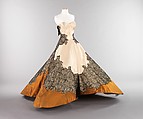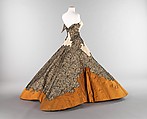"Clover Leaf"
Designer Charles James American
Not on view
Charles James produced some of the most memorable garments ever made. He began his design career in the 1930s. It peaked between the late 1940s and mid- 1950s, when his scarce and highly original gowns were sought after by society's most prominent women. Personally draping and constructing the garments that bear his label, he is considered to be the only American to work in the true couture tradition. James saw himself as an artist and sculptor of dress rather than a dressmaker. He manipulated fabrics into dramatic shapes using complex seaming and sometimes complicated understructures to create his singular vision of timeless elegance. A master of the relationship between form, color and texture, he often heightened the drama of his evening wear by combining several like fabrics of different colors, or different fabrics in like colors but with different light reflective qualities. Also a perfectionist, he worked for years on refining certain seam lines, shapes and constructs that particularly expressed his vision of artistry through rigorous engineering. Many of his pieces are conceived asymmetrically and possess a sense of movement and vitality that is a signature characteristic of his work. Many historical references in shapes and construction, especially the drapery forms of the 1870s and early teens, are also prevalent throughout his work.
For the Eisenhower Inaugural Ball of 1953, Austine Hearst, the wife of Mr. William Randolph Hearst, Jr., commissioned Charles James to create something for her to wear. Although the resulting garment was not, in typical Jamesian manner, completed in time for the function, it has since become one of the icons of mid-century couture and by James's own evaluation, his pinnacle in dressmaking.
Reworking a lobed hemline design in the 1930s and melding it with a quatrefoil millinery model of 1948, James fabricated a gown of four layers-and inner taffeta slip, a structured under petticoat, a matching petticoat flare, and an overdress. The garment expresses James's fascination with geometry and mathematics: while the four lobes are not of equal dimension, they readily fit within a circle. His eye for line and texture is demonstrated by the application the costliest silks: white duchess satin, black velours de Lyon, and ivory silk faille. Here James is a sculptor who happens to have selected fabric as his medium. The garment is constructed from thirty pattern pieces, twenty-eight of which are cut in duplicate, the remaining two singly. Once he had perfected the form he went on to create other similarly shaped garments, some of which were copies, others adaptations. The stole, with its petal outline, is of black silk velvet and white stain. It was adapted from the hipline yoke of a ball gown that James created in 1949.
Due to rights restrictions, this image cannot be enlarged, viewed at full screen, or downloaded.
This artwork is meant to be viewed from right to left. Scroll left to view more.











